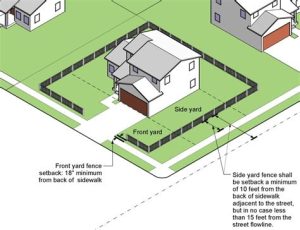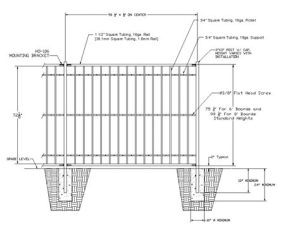Discover essential information on fence permit requirements, local regulations, application processes, height and material restrictions, and the risks of building without a permit.When considering the installation of an above-ground fence, one of the first questions that often arises is whether a permit is necessary. Understanding the specific requirements and regulations that govern fence construction in your area is crucial for ensuring a compliant and successful project. This blog post will guide you through the essential aspects of permit requirements for above-ground fences, including local building regulations, the application process, and any restrictions regarding fence height and materials. Additionally, we will delve into the potential consequences of proceeding without the proper permits, helping you make informed decisions and avoid costly mistakes. Let’s explore what you need to know before you start building your fence!
Understanding Permit Requirements
When considering the installation of an above-ground fence, one of the first questions that arise is whether a permit is necessary. Permit requirements can vary widely depending on your local jurisdiction. Therefore, it’s crucial to understand what your specific area mandates regarding fencing projects.
Generally, some common factors that determine whether you need a permit include the height of the fence, the location of your property, and the materials used. For instance, municipalities often require permits for fences over a certain height, typically between 4 to 6 feet. Additionally, fences that are constructed near property lines or in specific zones may require local approval.
Always check your local building codes before beginning any fencing project. Most municipalities have websites where you can find this information, or you can contact your city’s building department directly. Not obtaining the proper permit can lead to fines, the possibility of having to dismantle the fence, or even legal actions from neighbors.
Local Building Regulations for Fences
When it comes to building a fence, understanding the local building regulations is crucial. Each municipality has its own set of rules concerning fence construction, which may dictate everything from allowed materials to height limitations. Therefore, homeowners must familiarize themselves with these regulations to avoid fines or required modifications later on.
- Height Restrictions: Many areas have specific limits on how tall a fence can be. For example, front yard fences may be limited to 3-4 feet, while back yard fences might have a higher allowance.
- Material Restrictions: Local laws often regulate what materials can be used in fence construction. While wood, vinyl, and metal are common choices, some areas may prohibit the use of certain materials for aesthetic or safety reasons.
- Setback Requirements: These rules dictate how far from property lines a fence must be built. Proper adherence to these guidelines is crucial to avoid disputes with neighbors or penalties.
It’s also important to note that Homeowners Associations (HOAs) may have additional regulations regarding fences that are stricter than local laws. Be sure to check with your HOA, if applicable, before commencing work.
Ultimately, complying with local building regulations not only ensures the safety and aesthetic appeal of your property but also helps you maintain a good relationship with your neighbors and stay within legal bounds.
Permit Application Process
When considering the construction of a fence, it’s crucial to understand the permit application process. Acquiring a permit typically involves a series of steps designed to ensure compliance with local laws and regulations.
The first step in the permit application process usually requires homeowners to verify whether a permit is necessary for their specific fencing project. This can typically be done by contacting the local building department or checking their website for guidelines. Many regions have specific requirements based on the fence height, material, and location.
Once homeowners determine that a permit is necessary, the next step is to gather the required documentation. This may include detailed blueprints of the planned fence, photographs of the property, and information about neighboring structures. Properly filling out the application forms and submitting any fees will set the stage for a smoother approval process.
After submission, the local authority will review the application to ensure it adheres to all relevant building regulations. If approved, homeowners will receive the necessary permits, which must be displayed during the construction. Should any issues arise during the review, the department may request modifications or additional information.
| Steps in Permit Application Process | Details |
|---|---|
| Step 1: Verification | Contact local building department to see if a permit is needed. |
| Step 2: Gather Documents | Collect blueprints, photos, and application forms. |
| Step 3: Submit Application | Fill out forms, pay fees, and submit documentation. |
| Step 4: Review Process | Local authority reviews application for compliance. |
| Step 5: Receive Approval | Obtain permit and display it during construction. |
Fence Height and Material Restrictions
When considering the installation of an above-ground fence, one of the crucial factors is understanding the fence height and material restrictions set by local regulations. These restrictions can vary significantly based on your location, so it’s important to familiarize yourself with the specific laws governing your area.
In many jurisdictions, the allowed height for fences usually ranges from 4 to 6 feet in front yards, while backyards may permit heights of up to 8 feet or even more, depending on the locality. It is essential to check with your local zoning ordinances to ensure compliance. Some areas may also impose stricter regulations based on the neighborhood type and proximity to public areas.
In addition to height restrictions, certain materials may also be regulated. For example, some communities prohibit the use of chain-link fences in residential areas due to aesthetic considerations. Others may require that fences are constructed of materials that are safe and durable. Common materials such as wood, vinyl, and composite may be encouraged, while it’s vital to make sure that they adhere to any specific building codes related to durability and safety.
Consequences of Building Without a Permit
Building an above-ground fence without obtaining the necessary permits can lead to a variety of serious repercussions. Homeowners often underestimate the importance of adhering to local regulations, but failing to comply can yield significant consequences.
First and foremost, one major consequence is the possibility of hefty fines. Local authorities typically impose financial penalties on individuals who construct structures without proper authorization. These fines can vary depending on your location and the nature of the violation, but they can escalate quickly, leading to unexpected expenses.
Additionally, if it becomes evident that a fence was built illegally, the local government may require you to dismantle the structure. This entails not only the cost of taking down the fence but also the potential need to restore the area. This could involve landscaping, filling in holes, or other restorative measures, further adding to your financial burden.
Moreover, another hidden consequence is the risk of legal issues. Neighbors or homeowners’ associations may take legal action against you for encroaching upon their property lines or violating community standards. This could lead to significant stress and potentially costly legal battles.
To avoid these potential pitfalls, it is crucial to ensure that you have obtained the required permits before commencing any fence installation project.
Frequently Asked Questions
What is the purpose of obtaining a permit for an above-ground fence?
The purpose of obtaining a permit is to ensure that the fence complies with local zoning regulations, safety standards, and property lines.
How can I find out if I need a permit for my above-ground fence?
You can check with your local municipal office or zoning department to find out the specific regulations regarding permits for fences in your area.
What are the typical requirements for an above-ground fence permit?
Typical requirements may include submitting a fence design, specifying materials, providing property lines, and sometimes including a site plan.
What might happen if I build an above-ground fence without a permit?
Building without a permit can lead to fines, removal of the fence, and potential legal disputes with neighbors if the fence violates property lines.
Are there exceptions to needing a permit for an above-ground fence?
Yes, some areas allow for small fences or specific types of fences (like garden fences) to be built without a permit; however, this varies by location.
How long does the permit application process typically take?
The permit application process can take anywhere from a few days to several weeks, depending on the local government and the complexity of the project.
Can I start building my fence while waiting for the permit approval?
Generally, you should not start construction until you have received permit approval to avoid penalties and ensure compliance with local regulations.




